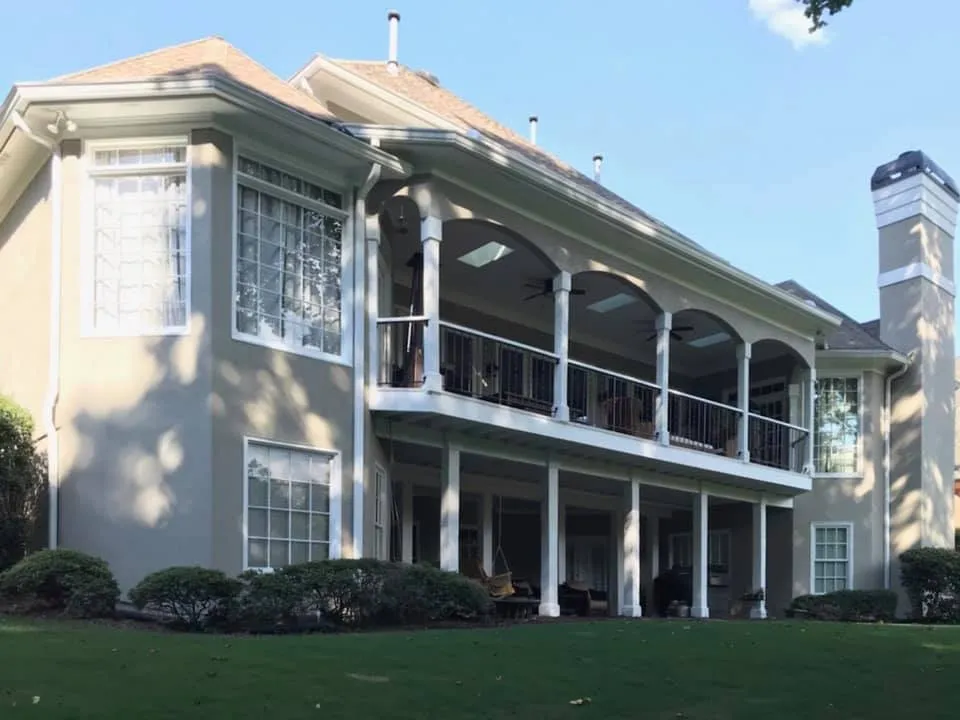Eifs Repair
Experience the transformative power of advanced stucco repair, a comprehensive solution for your commercial property that revitalizes exterior insulation and finish systems, enhancing durability and aesthetic appeal.
Have a question before scheduling?
Expert Stucco Installation & Repair for Homes and Businesses in Georgia
Experience predictable project costs with transparent pricing – materials, labor, and cleanup included. Proudly serving Georgia for over 24 years.
- Clear, upfront pricing with no hidden fees or surprises
- Prompt, local service—flexible scheduling for both homeowners and builders.
- Expert stucco installation and repair for commercial and residential properties.
- Clean, professional work zones with respect for your property and timeline.
- Easy estimates and communication with a responsive local team.
- Quality craftsmanship that meets local codes and enhances long-term value.

Our Stucco Process: What to Expect From Start to Finish
Request Your Quote
Tell us about your project – residential or commercial – and we’ll provide a detailed, no-obligation estimate with clear timelines.
On-Site Evaluation
We inspect the property to assess existing surfaces, moisture control, and project scope to ensure accurate pricing and flawless results.
Material Selection & Preparation
We help you choose the right stucco type, texture, and color for your building, then prep the surface for proper adhesion and durability.
Expert Application
Our licensed team applies each layer with precision — from scratch coat to finish coat — ensuring consistency, strength, and visual appeal.
Curing & Quality Inspection
After application, we allow proper curing time and perform a full quality check to confirm color uniformity, adhesion, and finish integrity.
Cleanup & Final Walkthrough
We leave the site clean and conduct a final walkthrough with you to guarantee satisfaction before closing out the project.
Revitalizing Your Property with EIFS Repair
EIFS repair breathes new life into your commercial property by restoring its exterior insulation and finish systems. This process not only enhances the durability of your building but also elevates its aesthetic appeal. Don’t let minor damages escalate; get in touch with us for a professional EIFS repair today.
- EIFS repair addresses common issues such as cracks, water damage, and discoloration.
- Our experienced team uses advanced techniques to ensure a thorough and lasting repair.
- Regular EIFS maintenance can prevent costly future repairs and extend the lifespan of your building’s exterior.
- A well-maintained EIFS contributes to energy efficiency, reducing overall operational costs.


EIFS Repair: A Key to Commercial Building Maintenance
Whether it’s a retail store, an office complex, or a hotel, EIFS repair is crucial for maintaining the exterior of commercial buildings. Given the constraints of tight budgets and strict timelines, Advanced Stucco Repair offers solutions that are both efficient and cost-effective. Our experts guide you in choosing the right approach to EIFS repair, ensuring your building maintains its aesthetic appeal while meeting all regulatory requirements.
- Advanced Stucco Repair provides expert guidance on the most effective methods for EIFS repair, considering your specific needs and constraints.
- We offer solutions that balance cost-effectiveness with quality results, making us a reliable choice for commercial property owners.
- Our team ensures all repairs adhere to industry standards and regulations, giving you peace of mind about your property’s compliance.
- We understand the importance of timely repairs and strive to complete projects within agreed timelines without compromising on quality.
Unveiling the Advantages of EIFS Repair
EIFS repair is a strategic investment that safeguards your commercial property’s exterior, enhances its visual appeal, and optimizes energy efficiency. It also mitigates potential risks associated with water damage and structural deterioration, ensuring a safe and comfortable environment for occupants.
- EIFS repair revitalizes the building’s exterior, making it more appealing to customers and visitors.
- It mitigates the risk of structural damage caused by water infiltration, enhancing the safety of your property.
- The energy efficiency gained through EIFS repair can lead to significant savings on heating and cooling costs.
- By preventing further deterioration, EIFS repair contributes to the longevity of your building, protecting your investment in the long run.

Take the Next Step Towards EIFS Restoration
Contact Advanced Stucco Repair today for a personalized consultation and quote on your EIFS repair needs. Let’s safeguard your commercial property together.
Our dedicated team at Advanced Stucco Repair is at-the-ready to provide you with great customer service and first class Eifs Repair. Reach out to us at (888) 592-1304 to discuss your Eifs Repair needs today!

Diving Deeper into the EIFS Repair Process
Our EIFS repair service involves a meticulous process that starts with a comprehensive inspection of your building’s exterior. We identify problem areas, such as cracks or water damage, and determine the best course of action. Our team utilizes top-notch equipment and industry-approved methods to ensure the repair is carried out effectively and efficiently.
- We begin with an in-depth assessment of your building’s exterior to pinpoint areas requiring repair.
- Our team employs cutting-edge tools and follows best practices for EIFS repair.
- We tailor our approach based on the specific needs of your property, ensuring optimal results.
- Throughout the process, we prioritize minimal disruption to your business operations.
- Post-repair, we provide detailed documentation outlining the work done for your records.
Investing in EIFS Repair: Understanding the Costs
The cost of EIFS repair is influenced by several factors including the extent of damage, accessibility to the repair site, risk factors associated with the repair, labor and time requirements, equipment used, and compliance with industry standards. As every building is unique, quotes for EIFS repair are tailored to the specific needs of your property.
- The scope of damage significantly impacts the cost; extensive repairs require more resources and time.
- Accessibility issues can increase labor costs due to additional equipment or time needed.
- Risk factors such as working at height or dealing with structural issues may influence the overall cost.
- Compliance with industry standards ensures quality but may affect pricing due to regulatory requirements.
- Market conditions and seasonality can also play a role in determining the cost of EIFS repair.


Common Commercial Scenarios Necessitating Stucco Restoration
Imagine a bustling shopping center with visible exterior cracks, or a high-rise office building struggling with water infiltration issues. In such scenarios, EIFS repair becomes an indispensable solution to restore the building’s integrity and aesthetics.
- A retail complex might need repair due to weather-induced damage.
- An office building could require restoration following water seepage.
- Hotels often seek EIFS repair for aesthetic enhancement.
- Industrial facilities might need it to improve energy efficiency.
Mastering the Steps of Effective EIFS Repair
Our EIFS repair process is a systematic approach that ensures thoroughness and efficiency. It begins with a detailed site evaluation to identify the extent of damage, followed by strategic planning for safety and compliance. The execution phase involves meticulous repair work, after which we provide comprehensive documentation for your records.
- Detailed site evaluation uncovers all areas requiring repair.
- Safety and compliance planning ensures adherence to industry standards.
- Execution phase involves precise repair work using advanced techniques.
- Post-repair, we provide comprehensive documentation outlining the services rendered.
- Throughout the process, we maintain open communication to keep you informed of progress.

Testimonials From Our Customers
At Advanced Stucco Repair, we believe that every exterior matters. Home and business owners trust us for expert stucco installation, repairs, and maintenance—whether it’s a single-family residence or a commercial building. We focus on dependable service, clear communication, and results that last.

Frequently Asked Questions About EIFS Repair
EIFS repair can seem complex, but we’re here to clarify. Below, we answer some common questions about the process and what to expect.
What does the scope of an EIFS repair entail?
The scope of an EIFS repair varies based on the extent of damage and the specific needs of your property. It could range from minor crack repairs to comprehensive restoration involving water damage mitigation and aesthetic enhancements.
How long does an EIFS repair typically take?
The duration of an EIFS repair depends on the severity of the damage and accessibility issues. While minor repairs might be completed within a few days, extensive restorations could take several weeks.
Will my business operations be disrupted during the repair?
We strive to minimize disruption to your business operations during the EIFS repair process. Our team works efficiently, often scheduling work during off-peak hours or in sections to limit any inconvenience.
How do you ensure safety and compliance during repairs?
Safety and compliance are paramount in our work. We adhere strictly to industry standards, use appropriate safety gear, follow risk management protocols, and ensure all repairs meet regulatory requirements.
How will I be kept informed about the progress of my EIFS repair?
We maintain open communication throughout the process. You’ll receive regular updates about progress made, any challenges encountered, and estimated timelines for completion.
